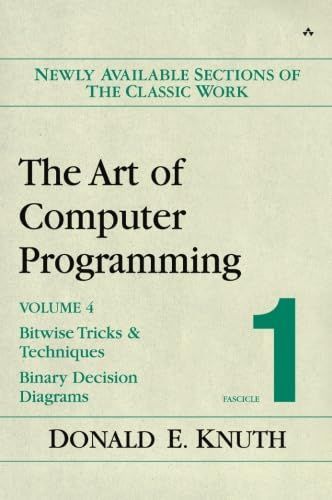
The Art of Computer Programming Bitwise Tricks and Techniques - Binary Decision Diagrams
Finally, after a wait of more than thirty-five years, the first part of Volume 4 is at last ready for publication. Check out the boxed set that brings together Volumes 1 - 4A in one elegant case, and offers the purchaser a $50 discount off the price of buying the four volumes individually. The Art of Computer Programming, Volumes 1-4A Boxed Set, 3/e ISBN: 0321751043 Art of Computer Programming, Volume 4, Fascicle 1, The: Bitwise Tricks & Techniques; Binary Decision Diagrams: Bitwise Tricks & Techniques; Binary Decision Diagrams This multivolume work on the analysis of algorithms has long been recognized as the definitive description of classical computer science. The three complete volumes published to date already comprise a unique and invaluable resource in programming theory and practice. Countless readers have spoken about the profound personal influence of Knuth's writings. Scientists have marveled at the beauty and elegance of his analysis, while practicing programmers have successfully applied his "cookbook" solutions to their day-to-day problems. All have admired Knuth for the breadth, clarity, accuracy, and good humor found in his books. To begin the fourth and later volumes of the set, and to update parts of the existing three, Knuth has created a series of small books called fascicles, which will be published at regular intervals. Each fascicle will encompass a section or more of wholly new or revised material. Ultimately, the content of these fascicles will be rolled up into the comprehensive, final versions of each volume, and the enormous undertaking that began in 1962 will be complete. Volume 4, Fascicle 1 This fascicle, enlivened by a wealth of Knuth's typically enjoyable examples, describes basic "broadword" operations and an important class of data structures that can make computer programs run dozens--even thousands--of times faster. The author brings together and explains a substantial amount of previously scattered but eminently practical information known only to a few specialists. The book also includes nearly five-hundred exercises for self-study, with detailed answers given in nearly every case; dozens of these exercises present original material that has never before been published. Simply put, this fascicle is a must-have for anybody who is faced with tough problems of a combinatorial flavor. It demonstrates how ordinary programmers can make use of powerful techniques that heretofore seemed to be available only to people who used specialized languages and software. It shows how ideas once thought to be "far out" are now ready to become a part of the programming mainstream.